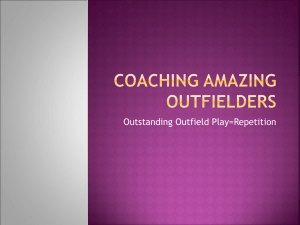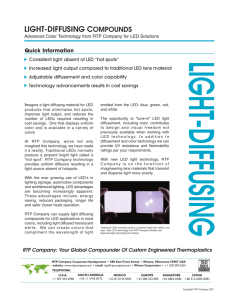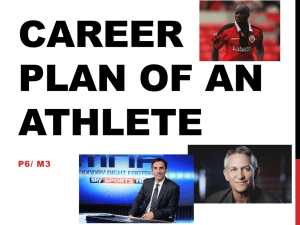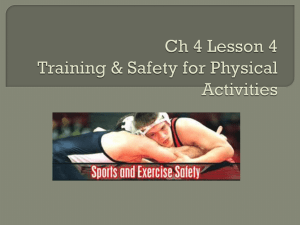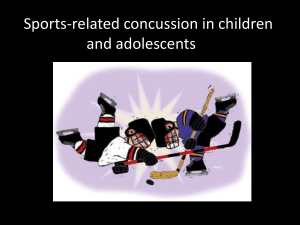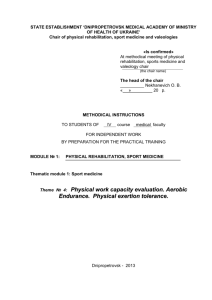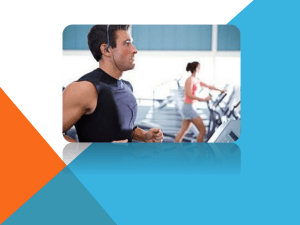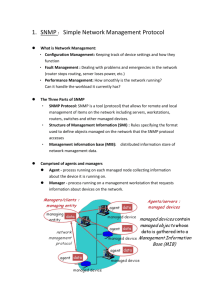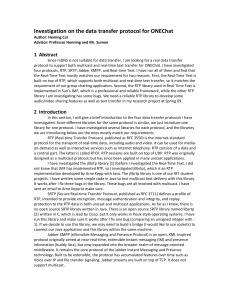PPT - Jacksonville Sports Medicine Program
advertisement
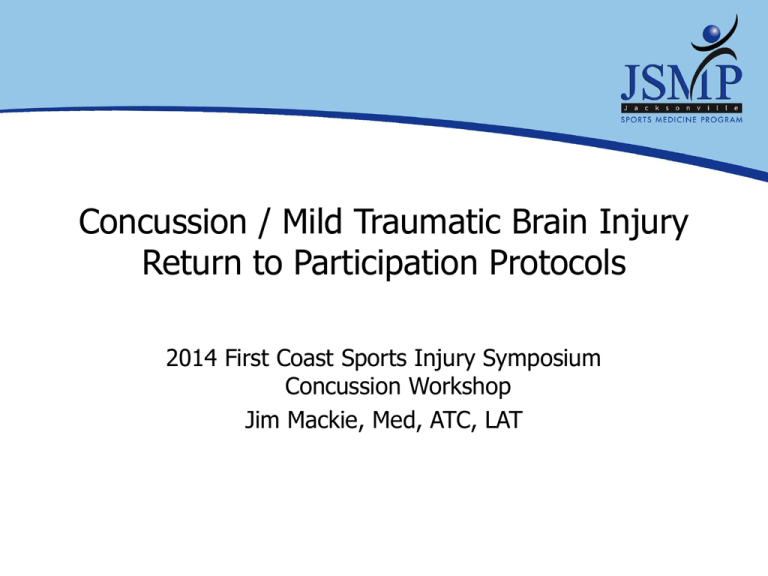
Concussion / Mild Traumatic Brain Injury Return to Participation Protocols 2014 First Coast Sports Injury Symposium Concussion Workshop Jim Mackie, Med, ATC, LAT International Consensus Statement Identifies the need for a gradual RTP protocol that includes a stepwise progression and only progress to the next level when asymptomatic at the current level. No cookie cutter return to play for all • Sports related concussions are heterogeneous (diverse in character or content) and require an individualized clinical approach. Collins, et all. • "A comprehensive, targeted approach to the clinical care of athletes following sport-related concussion" December 2013 Interdisciplinary team approach Targeted treatment pathways based on an individual's specific clinical trajectory and leveraging the interdisciplinary team's expertise, it is important to follow a standardized return to play (RTP) exertion protocol. Essential Relationships • Knowing your kids, involving peers, coaches, parents teachers in the process • Ask the following day, how did you feel during & after the exercise, How were you that evening? That next morning, today? • Ask about their school, social and home activities? Balance with a return to learn progression • Light cognitive activity at home • 1-2 hours a day in 30 minute increments • Sustained moderate activity with 30-45 minute increments for 3-4 hours • Progress the younger more gradually • School re-entry - as tolerated, no testing first week back Graded return to play protocol • • • • • What does this mean and what’s involved? What are you measuring and evaluating? Are you just doing activity or with a purpose? AT18 FHSAA Form Cleared by MD / DO to begin a graded RTP Six step process – AT18 1. 2. 3. 4. 5. 6. No Activity - Recovery Light aerobic exercise Sport – specific exercise Non-contact training Full Contact practice Return to full activity Step wise process • Each step to be completed in a 24 hour window • Any return of symptoms, stop immediately and wait 24 hours or until asymptomatic • Begin at the previous level • Performed under supervision of athletic trainer, coach with each step initialed and dated Step 2 - Light Aerobic Exercise • Asymptomatic and cleared to begin • Walking, swimming, stationary bike (10 – 15 min.), HR<40 – 50% max. • No Impact work or no weight training • Flexibility encouraged • Balance – Single leg or heel to toe • Quiet room with no distractions • Objective: Increased Heart rate Step 3 - Sport Specific Exercise Bike or treadmill (20-30 min., THR 40-60%) Dynamic stretching (walking lunges) Non contact drills Examples: Bags, ladder, cones, running, throwing, directional & agility drills • Objective: Add dynamic exertion & sport specific movement • • • • Introducing Dynamic Exertion • Incorporate dynamic (lateral, head & sport specific) plyometric based movements that could provoke underlying vestibular symptoms or dysfunction. • Assessment necessary to see if they have any return of vestibular or other symptoms following dynamic movements that mimic the sport. • Helps reduce recidivism and ensures a safer and more informed RTP. If undetected could lead to making one more susceptible to additional injuries Step 4 - Non-contact training • Increased aerobic exercise (THR 60-80%) • Complex (non-contact) drills / practice, balance & reach or multi task, bosu ball • Examples: Progressive Weight training, bag, ladder, cone drills, running, throwing, agility, plyometric, change of direction • Practice skill patterns of position • Objective: Exercise, coordination & cognitive load Sport specific position skill progressions • • • • • 5 – 10 – 20 yard or longer bursts Diagonals, stop / starts Roll out, plant & cut, back peddle, etc. Foot drills, change of direction Head turns, swivels, rotations… Step 5 - Full Contact Practice • Full contact Practice • Examples: Progressive intensity one on one, 7 on 7; blocking, locking up, tackling, controlled scrimmage (monitor number of reps) • Full lifting, running & performance training • Objective: Restore confidence and simulate game situations As an athletic trainer or other healthcare provider your initial and on-going clinical interviews will assist the MD with their treatment plan. Local Resources for RTP Help? • Identify the Schools Athletic Trainer • Local Rehab Centers that may offer supervised program Physician Communication • Office visit or not? • Depends upon physician (MD/DO) • Trust in person monitoring daily progress with Athletic Trainer, Coach, Therapist, etc. Step 6 -Return to full activity • • • • Return to competition Written documentation on file Monitor & report any return of symptoms Objective: After completion of each step successfully, Form AT18 must be completed by MD / DO Some considerations • Most RTP models start at Stage 1 & spend at least 24 hours before progressing to the next stage. • Definitely with the adolescent & younger athlete • Assumes that concussion recovery trajectories are homogenous and linear in nature Considerations & research shows • Example: athlete presents symptom free and neurocognitive test scores at baseline levels only 2 days post injury may or may not need to begin at Stage 2 exertion. The athletic trainer or individual may progress them through several stages in day one without provocation of symptoms. • However, symptoms alone may not be the best approach to assessing RTP following exertion. Final Considerations • Researchers showed 1/3rd athletes who were symptom free failed at least one neuro-cognitive test. • Indicates the need for a post exertion test if you feel they are being less than honest with their symptom reporting. • Regardless, all should complete a stepwise program of light aerobic exercise and progressing through sportspecific movements, light contact drills and final, full contact practice. Thank You Jim Mackie, Med, ATC, LAT Jacksonville Sports Medicine Program
